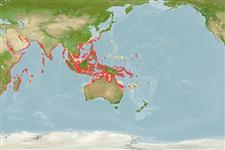>
Eupercaria/misc (Various families in series Eupercaria) >
Caesionidae (Fusiliers) > Caesioninae
Etymology: Caesio: Latin, caesius, bluish-grey, 1835; it is the same name given to the silvery metal (Cs) (Ref. 45335).
More on author: Cuvier.
Environment: milieu / climate zone / depth range / distribution range
Sinh thái học
Biển Cùng sống ở rạn san hô; không di cư; Mức độ sâu 0 - 50 m (Ref. 402). Tropical; 31°N - 28°S, 32°E - 167°E (Ref. 402)
Indo-West Pacific: Red Sea, Persian Gulf and East Africa to the Solomon Islands, north to southern Japan.
Bộ gần gũi / Khối lượng (Trọng lượng) / Age
Maturity: Lm ? range ? - ? cm
Max length : 40.0 cm TL con đực/không giới tính; (Ref. 402)
Các tia vây lưng cứng (tổng cộng) : 10; Các vây lưng mềm (tổng cộng) : 13 - 15; Tia cứng vây hậu môn: 3; Tia mềm vây hậu môn: 10 - 11. This species is distinguished by the following characters: a single postmaxillary process; D X, usually 14 soft rays; A III, usually 11soft rays; supratemporal band of scales generally interrupted at dorsal midline by a narrow scaleless zone; lateral line scales modally 49; scales above lateral line to dorsal -fin origin 7-10 (modally 8), below lateral line to anal-fin origin 14-19; predorsal scales 20-26; greatest body depth 2.2-3.1 in SL, head length 2.7-3.4 in SL; colour of body bluish, belly paler than upper sides; tips of caudal fin lobes, axil of pectoral fins, and upper base of pectoral fins black; caudal fin blue (except in juveniles where caudal fin and portions of caudal peduncle often yellow); pectoral, pelvic, and anal fins white to pale blue (pink or reddish after death); dorsal fin bluish (Ref. 68703, 90102).
Adults are found in coastal areas, mainly on or near coral reefs (Ref. 30573). They are more common along steep seaward reefs than in lagoons (Ref. 9710). They form large aggregations in midwater on upper edge of steep slopes and around patch reefs, often with other fusiliers (Ref. 90102). They feed on zooplankton. Are oviparous, with numerous, small pelagic eggs (Ref. 402).
Life cycle and mating behavior
Chín muồi sinh dục | Sự tái sinh sản | Đẻ trứng | Các trứng | Sự sinh sản | Ấu trùng
Carpenter, K.E., 1987. Revision of the Indo-Pacific fish family Caesionidae (Lutjanoidea), with descriptions of five new species. Indo-Pac. Fish. (15):56 p. (Ref. 1723)
IUCN Red List Status (Ref. 130435: Version 2024-2)
Threat to humans
Harmless
Human uses
Các nghề cá: buôn bán nhỏ
Các công cụ
Special reports
Download XML
Các nguồn internet
Estimates based on models
Preferred temperature (Ref.
123201): 24.7 - 29.2, mean 28.2 °C (based on 1494 cells).
Phylogenetic diversity index (Ref.
82804): PD
50 = 0.5020 [Uniqueness, from 0.5 = low to 2.0 = high].
Bayesian length-weight: a=0.01698 (0.00895 - 0.03223), b=3.09 (2.92 - 3.26), in cm total length, based on LWR estimates for this species & (Sub)family-body (Ref.
93245).
Mức dinh dưỡng (Ref.
69278): 3.4 ±0.45 se; based on food items.
Thích nghi nhanh (Ref.
120179): Chiêù cao, thời gian nhân đôi của chủng quần tối thiểu là dưới 15 tháng (Preliminary K or Fecundity.).
Fishing Vulnerability (Ref.
59153): Low to moderate vulnerability (30 of 100).
Nutrients (Ref.
124155): Calcium = 53.2 [35.4, 76.6] mg/100g; Iron = 0.708 [0.466, 1.023] mg/100g; Protein = 19 [18, 20] %; Omega3 = 0.138 [0.096, 0.196] g/100g; Selenium = 33.1 [21.1, 55.5] μg/100g; VitaminA = 99.1 [41.3, 244.0] μg/100g; Zinc = 1.1 [0.8, 1.5] mg/100g (wet weight);
